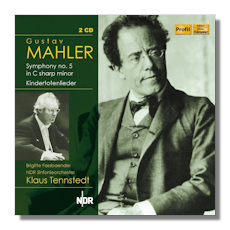
The Internet's Premier Classical Music Source
Related Links
- Mahler Reviews
- Latest Reviews
- More Reviews
-
By Composer
-
Collections
DVD & Blu-ray
Books
Concert Reviews
Articles/Interviews
Software
Audio
Search Amazon
Recommended Links
Site News
 CD Review
CD Review
Gustav Mahler

- Symphony #5
- Kindertotenlieder *
* Brigitte Fassbaender, mezzo-soprano
North German Radio Symphony Orchestra/Klaus Tennstedt
Profil Hänssler PH13058 2CDs 1:39:44
Profil Hänssler have given us a fine live recording of Mahler's Symphony #5 from Klaus Tennstedt and the North German Radio Symphony Orchestra (NDR Sinfonieorchester), with a live performance of the Kindertotenlieder sung by Brigitte Fassbaender on a second disc. The performances date from 1980 (May 18 and November 11 respectively), towards the end of Tennstedt's two-year stint as principal conductor of the NDR orchestra, shortly before he handed over the reins to Günter Wand.
Mahler's Fifth can present challenges to the unwary. The symphony has a complex tripartite structure with two pairs of outer movements surrounding the Scherzo that is the true heart of the symphony. It has some wonderful opportunities for soloists (particularly for solo horn in the Scherzo), and the well-known Adagio can side-track conductors who slip into playing it as a standalone piece. Although the symphony is more conventional than the Second, Third, and Fourth, it has complex orchestration and internal structure, particularly in the second and final movements.
The very assertive trumpet fanfare that opens the first movement sets the tone for the rest of the performance. Tennstedt and the NDR give a forceful and assured reading. Conductor and orchestra are both clearly at home with Mahler's musical idiom and, more intangibly, with his musical temperament. In the opening movement the multiple voices come out clearly, with the dominant funeral march adroitly juxtaposed with the two trios. The NDR brass section has a very clear sound. Tennstedt and the NDR live up to the indication for the second movement, which is "moving stormily, with the greatest vehemence". They tread with assurance and energy through the complex development, bringing out thematic contrasts and juxtapositions. The brass section continues to shine in the Scherzo, which is played as the centerpiece that it is. The Adagio is played with luscious string sound and great emotion, but also maintaining the forceful momentum characteristic of the performance as a whole. In the final Rondo conductor and orchestra display a sure-footed sense of direction through a very complex movement full of allusions and sudden shifts of mood and tempo. Tennstedt brings the movement and symphony to a decisive close.
All in all the Fifth is a very strong performance. Turning to the second disc, Brigitte Fassbaender was an exceptional singer at the height of her powers in 1980. However, I found the performance of the Kindertotenlieder less compelling. There aren't any obvious identifiable flaws in singing or playing, but the performance doesn't quite catch the atmosphere of complete despair in the five poems that Mahler selected from the 428 that Rückert wrote in 1833-4 following the death of two of his children from scarlet fever. It is a shame that including the Kindertotenlieder on a separate disc only adds 26 minutes of music but effectively doubles the price. The sound quality on both performances is high, but I think that Profil would have been better advised to issue the performance of the Fifth on its own.
Copyright © 2015, José Luis Bermúdez





















